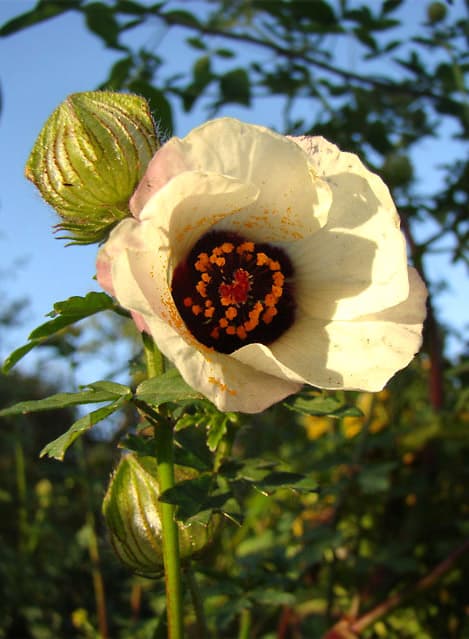An annual herbaceous plant with a strong branched stem (up to 70 cm) and original trifoliate leaves from the Malvaceae family.
In the northern regions, it is grown through seedlings (sowing in March). Prefers sunny places with loose, moist soil. It blooms in July-September, with yellow-cream flowers with a purple center, up to 4 cm in diameter. After the corolla falls, a fruit is formed on the peduncle - a multi-seeded capsule with oval-heart-shaped, dark seeds.
A feature of this species is the fact that the flowers open in the morning for only a few hours, and close in the afternoon...
Hibiscus trionum blooms for more than a month, because a new bud is formed in the axil of each leaf, and if optimal conditions are created, new flowers will appear daily.
The plant is very decorative and is perfect for decorating flowerbeds, borders and garden fences.
The development cycle from sprout to first fruits is 60-70 days. Seeds fall out of the capsules and litter the soil. The germination of freshly fallen seeds is low. The minimum germination temperature is +5+6°C. Cotyledons are 7-9 mm long, 6-8 mm wide, rounded.
The viability of seeds lasts up to 5-7 years. The weight of 1000 seeds = 3-4 g.
Hibiscus trionum grows naturally on slopes in river valleys, along banks and on sandbanks. It is a good honey plant. It spreads strongly by self-seeding, so cultivated plantings, strictly define its habitat.
Dried shoots with unusual "swollen" fruits look great in dry bouquets.

Flower-of-an-hour, Bladder hibiscus, Bladder ketmia, Bladder weed, Modesty, Puarangi, Shoofly, Venice mallow.
Hibiscus trionum has antibiotic properties against Staphylococcus aureus.
Leaves, roots, flowers and seeds are widely used in Chinese medicine. A decoction of roots and leaves is used as an emollient and expectorant. A decoction of leaves has diaphoretic and diuretic properties. An infusion of flowers is used for itching and skin dermatitis.
Roots, grass, fruits and seeds are used for medicinal purposes. All organs contain rubber-like substances. Flavonoids and polysaccharides are found in the above-ground part of the plant. The seeds contain fatty oil.
An infusion of the herb is used as a diuretic and for rabies.
A decoction of roots and grass is used in Chinese medicine as an emollient.
A decoction and syrup from the leaves are excellent diaphoretic.
An infusion of leaves is used as an expectorant for coughs.
The juice of fresh leaves is used to remove warts.
An infusion of flowers is used for skin diseases and itching, and also as a diuretic.
• 12 g of chopped dry herb per 1 cup of boiling water, leave for 2 hours, strain. Take 1/4-1/3 cup 3 times a day for itching, dermatitis, acne or as a diuretic.
• 10 g of fresh leaves per 1 cup of boiling water, leave for 2 hours, strain. Take 1/3 cup 3 times a day as a diuretic or take 1/3-1/2 cup for cough as an expectorant.












